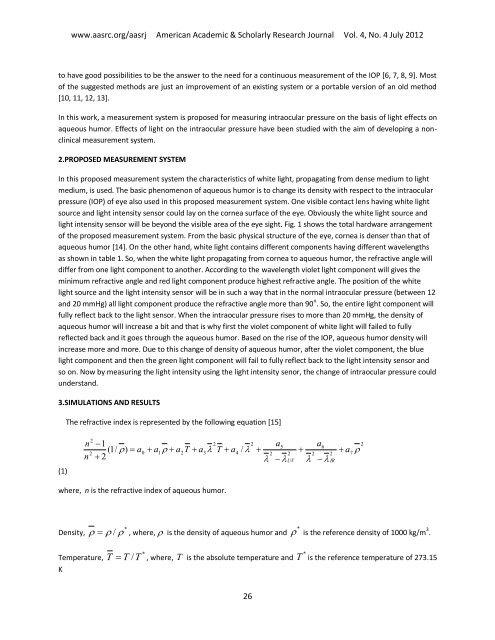E - American Academic & Scholarly Research Center
E - American Academic & Scholarly Research Center
E - American Academic & Scholarly Research Center
You also want an ePaper? Increase the reach of your titles
YUMPU automatically turns print PDFs into web optimized ePapers that Google loves.
www.aasrc.org/aasrj <strong>American</strong> <strong>Academic</strong> & <strong>Scholarly</strong> <strong>Research</strong> Journal Vol. 4, No. 4 July 2012<br />
to have good possibilities to be the answer to the need for a continuous measurement of the IOP [6, 7, 8, 9]. Most<br />
of the suggested methods are just an improvement of an existing system or a portable version of an old method<br />
[10, 11, 12, 13].<br />
In this work, a measurement system is proposed for measuring intraocular pressure on the basis of light effects on<br />
aqueous humor. Effects of light on the intraocular pressure have been studied with the aim of developing a nonclinical<br />
measurement system.<br />
2.PROPOSED MEASUREMENT SYSTEM<br />
In this proposed measurement system the characteristics of white light, propagating from dense medium to light<br />
medium, is used. The basic phenomenon of aqueous humor is to change its density with respect to the intraocular<br />
pressure (IOP) of eye also used in this proposed measurement system. One visible contact lens having white light<br />
source and light intensity sensor could lay on the cornea surface of the eye. Obviously the white light source and<br />
light intensity sensor will be beyond the visible area of the eye sight. Fig. 1 shows the total hardware arrangement<br />
of the proposed measurement system. From the basic physical structure of the eye, cornea is denser than that of<br />
aqueous humor [14]. On the other hand, white light contains different components having different wavelengths<br />
as shown in table 1. So, when the white light propagating from cornea to aqueous humor, the refractive angle will<br />
differ from one light component to another. According to the wavelength violet light component will gives the<br />
minimum refractive angle and red light component produce highest refractive angle. The position of the white<br />
light source and the light intensity sensor will be in such a way that in the normal intraocular pressure (between 12<br />
and 20 mmHg) all light component produce the refractive angle more than 90 o . So, the entire light component will<br />
fully reflect back to the light sensor. When the intraocular pressure rises to more than 20 mmHg, the density of<br />
aqueous humor will increase a bit and that is why first the violet component of white light will failed to fully<br />
reflected back and it goes through the aqueous humor. Based on the rise of the IOP, aqueous humor density will<br />
increase more and more. Due to this change of density of aqueous humor, after the violet component, the blue<br />
light component and then the green light component will fail to fully reflect back to the light intensity sensor and<br />
so on. Now by measuring the light intensity using the light intensity senor, the change of intraocular pressure could<br />
understand.<br />
3.SIMULATIONS AND RESULTS<br />
(1)<br />
The refractive index is represented by the following equation [15]<br />
2<br />
n �1<br />
( 1/<br />
2<br />
n � 2<br />
2<br />
2<br />
�) � a0<br />
� a1<br />
� � a2T<br />
� a3�<br />
T � a4<br />
/ � � 2<br />
5<br />
2 � 2<br />
6<br />
2 � a7<br />
UV<br />
IR<br />
where, n is the refractive index of aqueous humor.<br />
26<br />
a<br />
� � �<br />
*<br />
Density, � � � / � , where, � is the density of aqueous humor and<br />
a<br />
� � �<br />
�<br />
*<br />
� is the reference density of 1000 kg/m 3 .<br />
*<br />
*<br />
Temperature, T � T /T , where, T is the absolute temperature and T is the reference temperature of 273.15<br />
K<br />
2


